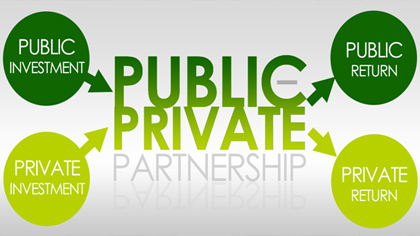Public–private partnership
 A public- Private partnership (PPP) is a public and private sector arrangement for support, typically it is meant for a long term arrangement.
Throughout history, different governments have used this arrangement as combinations to achieve different objective. For the past few years', different government around the globe have used this arrangement to achieve various goals.
A public- Private partnership (PPP) is a public and private sector arrangement for support, typically it is meant for a long term arrangement.
Throughout history, different governments have used this arrangement as combinations to achieve different objective. For the past few years', different government around the globe have used this arrangement to achieve various goals.
The private partner assumes the hitherto traditional role of the public entity - of delivering services to the general public - under conditions that are monitored, independently or by a Government agency, regulated or left to the market, depending on the nature of the services/assets. It is important to note, though, that the ultimate accountability to users for provision of these services continues to remain with the public entity, even if the delivery is by the private partner.
Elements of Public-Private Partnership
- Strategic mode of obtaining
- Outcome coordination
- Value for Money
- Common risks and resources
- A prescribedarrangement between the public sector and the private sector
- Acceleration of infrastructure establishment and faster application.

Different Types of ProjectsUnder PPPs
Here are the lists of activities which may be undertaken under any of the recognized and valid contractual arrangements. These include, among others:- Railways or rail-based projects that may or may not be packaged with commercial development opportunities;
- Highways, including expressways, roads, bridges, interchanges, tunnels, and related facilities;
- Port infrastructures like piers, wharves, quays, storage, handling, ferry services and related facilities;
- Airports, air navigation, and related facilities;
- Power generation, transmission, sub-transmission, distribution, and related facilities;
- Telecommunications, backbone network, terrestrial and satellite facilities and related service facilities;
- Irrigation and related facilities;
- Water supply, sewerage, drainage, and related facilities;
- Education and health infrastructure;
- Land reclamation, dredging and other related development facilities;
- Industrial and tourism estates or townships, including ecotourism projects such as terrestrial and coastal/marine nature parks, among others and related infrastructure facilities and utilities;
- Government buildings, housing projects;
- Markets, slaughterhouses, and related facilities;
- Warehouses and post-harvest facilities;
- Information technology (IT) and data base infrastructure, including modernization of IT, geo-spatial resource mapping and cadastral survey for resource accounting and planning;
- Public fish ports and fishponds, including storage and processing facilities;
- Environmental and solid waste management related facilities such as, but not limited to, collection equipment, composting plants, landfill and tidal barriers, among others; and
- Non-rail based mass transit facilities, navigable inland waterways and related facilities;
- Climate change mitigation and adaptation infrastructure projects and related facilities.

Benefits of PPP
In general, governments tap public-private partnership (PPP) for the following reasons:- Private sector capital is used in PPP.
- Official development assistance is limited and is subject to government priority. Private sector funding, on the other hand, is readily available. It may be tapped to supplement funds and the government budget to implement desired government projects.
- In the case of big ticket infrastructure projects, PPPs utilize the financial capital of the private sector. Through it, project construction and service delivery is accelerated.
- Projects are affordable in PPP.
- If a project is undertaken by PPP then the government spending will be less, the cost is shared between the PPP and government. The private sector not only funds the project but operates and maintains the project during the period of concession. The eventually lower the capital and operating cost for government.
- PPP projects supporters typically support with most cost efficient capital goods required for the projects.
- Value for money is delivered in PPPs.
- Value for Money only comes in to achievement when the project obtains the maximum profit from the services and goods which they provide and acquire. The best outcome of profit will be after taking all the benefits, costs and risk under consideration for the entire project life.
- Risk is allocated to the party who can best manage or absorb it in PPPs.
- Generally risks are accepted by either of the parties who are capable of handling it better and accept the consequences which will rise thought it.
- Risk is shared in PPP between the parties therefore government has to take fewer risk. Generally, the private sector takes on the project's life cycle cost risk, while the government assumes site risks, legislative and government policy risks, among others.
- The focus of private sector from the start will be on outputs and benefits from the start in PPP.
- In public – Private partnerships project groundwork preparation activities are very strict. This ensures the project to be bankable and can stand for scrutiny any time. This will ensure the timely completion of project with in the stipulated time period.
- When the project is provided with quality infrastructure and services by the government. Then the focus of performance and standards will be immense, this in return will in the standard and timely complication of the projects.
- The quality of service has to be maintained for the entire duration of the cooperation period in PPPs.
- The owners of the project, the promoters will execute the project very rigorously as the entire project belongs to them. The payments are done only after the services are being made satisfactorily by the public sector.
- In PPPs, there is an independent consultant hired to ensure that both public and private parties observe to the terms of the contract upon completion of every stage in the project.
- Innovation is encouraged in PPPs.
- Private sector skills are highly increased with the utilization of higher level of private sector efficiency, specialization and technology in PPPs.


